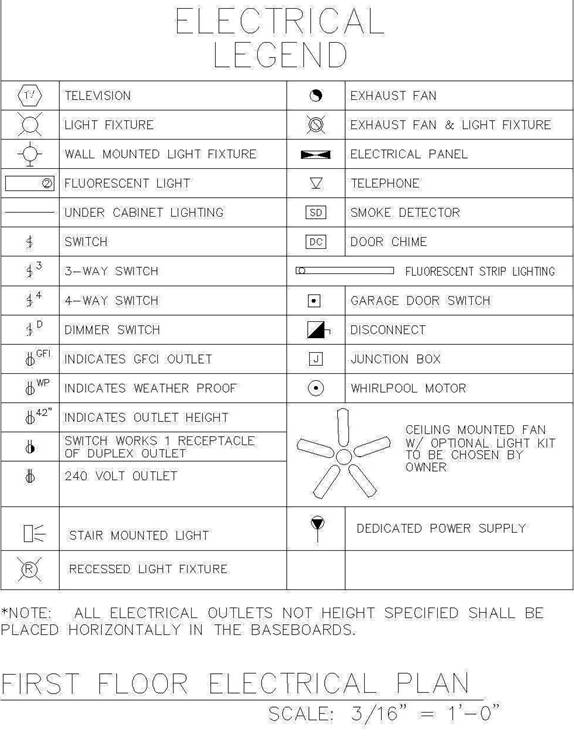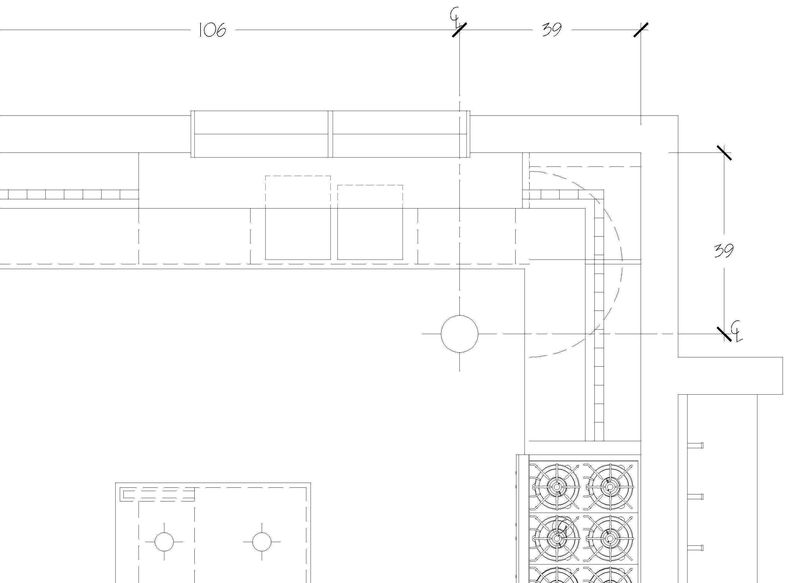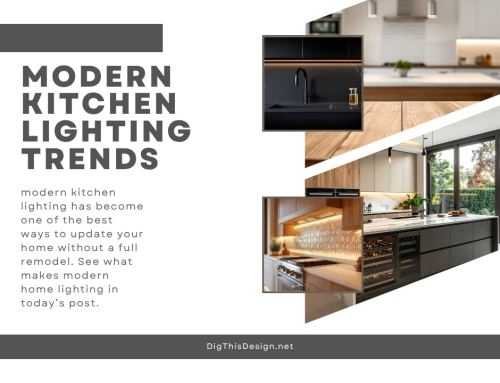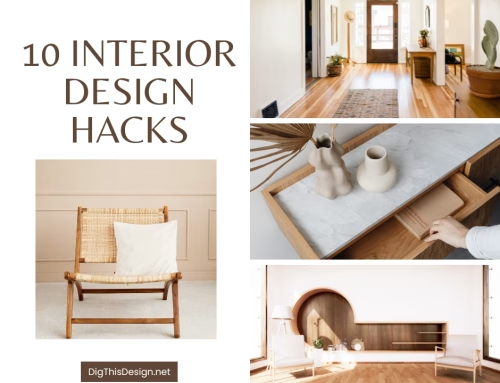There are three very important aspects to correctly lighting a room that will determine how the light will hit the space.
- Choosing the lamp specifications
- Placement of the fixture in the room on the ceiling
- The color temperature of the lamp
Choosing the Lamp Specifications
I am an Interior designer that knows the value of a good lighting plan. So many times I ask my clients about their lighting design and they tell me not to worry because their architect has done a plan. The example below is an actual lighting legend I received in a set of architectural plans, which is typical.
To a layperson, you would think you have the lighting covered but, in fact, this legend has no specifications for the type of fixture or the lamp being placed into the fixture, it is just a legend of lighting symbols. Why is this important? Because each lamp comes with measured beam spreads and candlepower that will determine how the light will hit the space. A true lighting plan is mathematically formulated to fit the space.
(EXAMPLE OF A TYPICAL LIGHTING LEGEND THAT COMES IN A SET OF PLANS)
In the example above the home, lighting legend has no specifications. This example only shows lighting symbols, which means there was not a formulated lighting design. It is left wide open for interpretation. Below is an example of a TRUE LIGHTING LEGEND, listing the fixture and the lamps, leaving no question as to what is to be placed in the fixture for proper formulation of light.
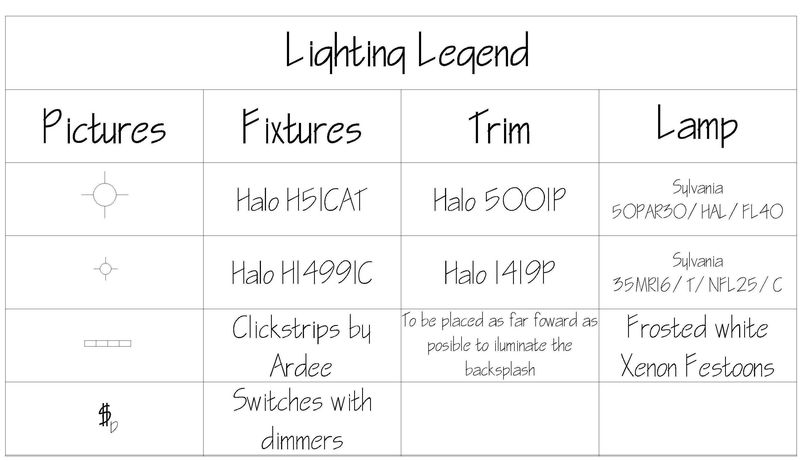
(EXAMPLE OF A TRUE LIGHTING LEGEND)
Sometimes the wattage is specified on a lighting legend. Wattage tells how much electricity the lamp will burn which doesn’t help because a 50 watt lamp can come in many different beamspreads and candlepowers. What happens is it is left to the electrician onsite to pick the lamp and he will grab one off the shelf with no thought of what is needed, it’s not his job. Wattage tells nothing about the amount of light a lamp can produce. Candlepower is a lamp measurement. It measures the focused quantity or intensity of directional lamps (recessed cans). A lighting designer measures the candlepower and formulates how much is needed at that area.
Placement of the Fixture in the Room on the Ceiling
Another important part of the equation is where the lamp will be placed in the room. This will affect how the beam spread will hit the space. If you get a lighting plan with your set of architectural plans and there is no center line on any of the fixtures then nothing has been formulated to determine that and it is left up to the guy in the field to decide and you do not want that.
( EXAMPLE OF CENTERLINE OF FIXTURE FOR PLACEMENT)
This is important in figuring how the beam spread will impact the design. The illustration below shows the beam spread missing the face of the wall cabinet and hitting the countertop. If the fixture was placed too close to the wall the beam spread would intersect the face of the cabinet creating a harsh scallop of light on the face of the cabinet and not covering the counter space as it should. To avoid this, the lighting designer would figure the degree of beam spread with the proper candlepower for the height of the ceiling and calculate placement.
(This illustration shows the proper calculation of beam spread in relationship to cabinetry and countertop.)
Layered Lighting Designs
Kitchens and baths should have a layered lighting design. Dimmer switches should be installed giving the user full control to set their scene.
This is much more aesthetically pleasing because you can pick your scene but, more importantly, this ensures enough light at task areas where it is absolutely needed.
Task areas have triple the candlepower to the general areas which need just enough light to navigate safely.
The following two pictures are of kitchens, one where the architect did not specify a true lighting design and one that had a true formulated lighting plan done. Can you pick the one with a true lighting plan?
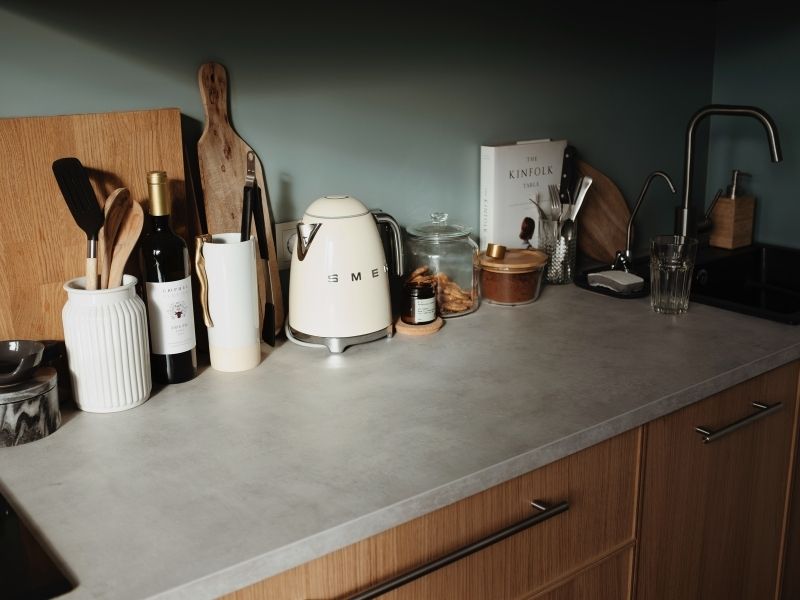
Example “A” shows a kitchen with no lighting design over the task areas, the island, and the sink. The mullion glass display cabinet is not lit and fails to focal point what was meant to be seen.
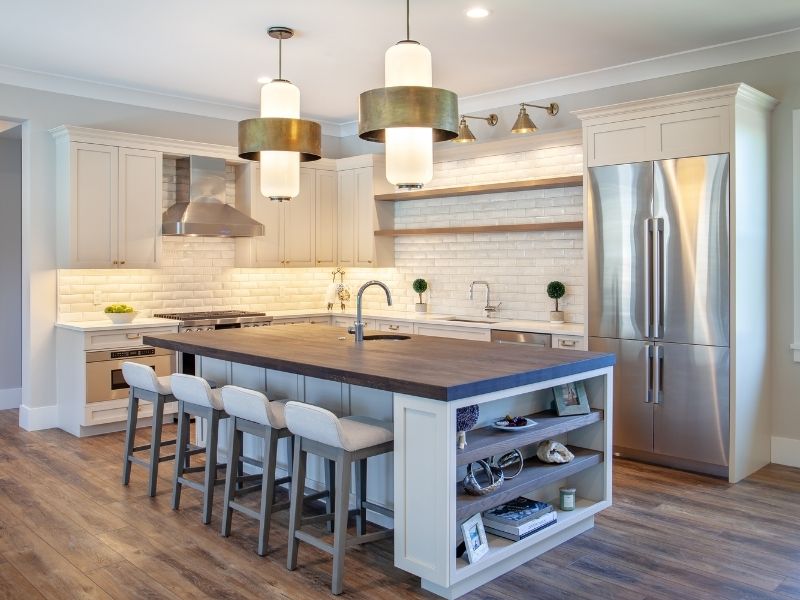
Example “B” shows a layered lighting design. The task areas have sufficient light at the counter. The glass cabinets with dark interiors are lit evenly by running the lighting vertical illuminating each shelf. Having an expert design your lighting can mean the difference as seen above.
Color Temperature of the Lamp
LED is a relatively new player in this field and it is important to know how to work with this technology. One of the biggest complaints of LED lighting is the consistency of the color they put out.
In incandescent and halogen lamps the color rendition index, CRI is at 100 which is perfect. The CRI is a measured number between 1-100, all colors read the true at a measurement of 100 which is what you are striving for, keeping your finished colors true, not greyed out. You give up some quality in the color by going with LED but, for the energy savings, most of us are willing to give up some.
It’s important to know a little bit about CRI so you do not end up turning your custom mosaic tiles into an unexpected ugly green color. You want to try to purchase LED lamps with a Kelvin temperature between 2700K and 2800K, giving a CRI of 90 – 95 at best.
Above or below these numbers will lend the color temperature to be too cold or too warm and change the color of the finishes in the room.
You Deserve a Great Lighting Plan!
Every kitchen and bath deserves a good lighting plan especially yours! So, now you have the tools to determine if your plan is a correct lighting plan and if not, by all means, hire someone to do it right because it is too expensive to change it later.
As the old saying goes, “If you fail to plan, you plan to fail “
~Benjamin Franklin
Decorative lighting is about the character you want to bring out in your design, the finishing touch so to speak. Below I am sharing some of my favorite picks of products I have used to make a statement in design.
Click here for a post showing the two products in the application.
Adorne by Legrand is a unique product that allows you to do the finishing touches on all your light switches and outlets. They offer a variety of color and finish choices to go with any room décor. Recently, they have collaborated with Hubbardton Forge to add six lustrous metal plates to match their decorative lighting, a marriage made in design heaven!
I understand how stressful an interior design project can be. You may need someone to guide you, help to explain all those choices, and point you in the right direction. I’m available for consultation via Skype for your interior design project, no matter the size.
Our virtual session will include a document detailing everything discussed. Feel free to contact me prior to setting up a consultation.
Other Posts You Might Enjoy:
Beautify Your Business or Home: The Benefits of Architectural Lighting Design
How To Bring Life To Your Home Through Lighting Fixtures

